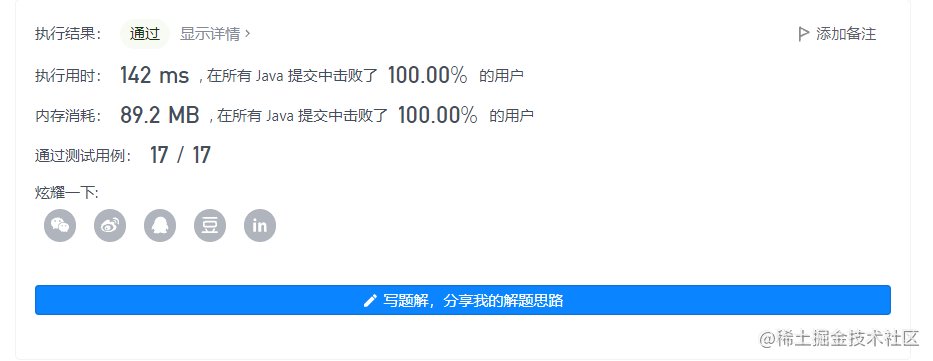5895. 获取单值网格的最小操作数
给你一支股票价格的数据流。数据流中每一条记录包含一个 时间戳 和该时间点股票对应的 价格 。
不巧的是,由于股票市场内在的波动性,股票价格记录可能不是按时间顺序到来的。某些情况下,有的记录可能是错的。如果两个有相同时间戳的记录出现在数据流中,前一条记录视为错误记录,后出现的记录 更正 前一条错误的记录。
请你设计一个算法,实现:
更新 股票在某一时间戳的股票价格,如果有之前同一时间戳的价格,这一操作将 更正 之前的错误价格。
找到当前记录里 最新股票价格 。最新股票价格 定义为时间戳最晚的股票价格。
找到当前记录里股票的 最高价格 。
找到当前记录里股票的 最低价格 。
请你实现 StockPrice 类:
- StockPrice() 初始化对象,当前无股票价格记录。
- void update(int timestamp, int price) 在时间点 timestamp 更新股票价格为 price 。
- int current() 返回股票 最新价格 。
- int maximum() 返回股票 最高价格 。
- int minimum() 返回股票 最低价格 。
示例 1:输入:
["StockPrice", "update", "update", "current", "maximum", "update", "maximum", "update", "minimum"]
[[], [1, 10], [2, 5], [], [], [1, 3], [], [4, 2], []]
输出:
[null, null, null, 5, 10, null, 5, null, 2]解释:
StockPrice stockPrice = new StockPrice();
stockPrice.update(1, 10); // 时间戳为 [1] ,对应的股票价格为 [10] 。
stockPrice.update(2, 5); // 时间戳为 [1,2] ,对应的股票价格为 [10,5] 。
stockPrice.current(); // 返回 5 ,最新时间戳为 2 ,对应价格为 5 。
stockPrice.maximum(); // 返回 10 ,最高价格的时间戳为 1 ,价格为 10 。
stockPrice.update(1, 3); // 之前时间戳为 1 的价格错误,价格更新为 3 。// 时间戳为 [1,2] ,对应股票价格为 [3,5] 。
stockPrice.maximum(); // 返回 5 ,更正后最高价格为 5 。
stockPrice.update(4, 2); // 时间戳为 [1,2,4] ,对应价格为 [3,5,2] 。
stockPrice.minimum(); // 返回 2 ,最低价格时间戳为 4 ,价格为 2 。

解题思路
- void update(int timestamp, int price) 在时间点 timestamp 更新股票价格为 price 。
- int current() 返回股票 最新价格 。
- int maximum() 返回股票 最高价格 。
- int minimum() 返回股票 最低价格 。
我们的目标是实现上述4个方法。
- int current() 返回股票 最新价格。我们只需要维护两个变量,最大的时间戳以及对应的价格即可
- 而对于其他方法,我们需要读取的是股票的最低以及最高价格,但是update方法会更正某些时间戳的价格,因此股票的最高和最低价格是动态更新的。使用一个treemap,维护价格和时间戳的对应关系,对于某个价格,该股票可能有多个对应的时间戳,利用treemap的特性我们可以在o(1)的时间复杂度内获取当前最大和最小价格。我们可以使用map维护每个时间戳对应的价格。
- 而update方法就需要维护上面的两个map。通过map,我们可以得到需要更新的时间戳原价是多少,再通过这个价格,定位到treemap里面,删除该时间戳。然后再将该时间戳和价格的对应关系插入到map和treemap里面
代码
class StockPrice {//timeStamp ->priceMap<Integer, Integer> map = new HashMap<>();//price -> timeStampsTreeMap<Integer, Set<Integer>> up = new TreeMap<>();int curTime=-1,curPrice=-1;public StockPrice() {}public void update(int timestamp, int price) {if (timestamp>=curTime){curTime=timestamp;curPrice=price;}if(map.containsKey(timestamp)){Integer old = map.get(timestamp);up.get(old).remove(timestamp);if (up.get(old).isEmpty())up.remove(old);}map.put(timestamp, price);if (!up.containsKey(price))up.put(price,new HashSet<>());up.get(price).add(timestamp);}public int current() {return curPrice;}public int maximum() {return up.lastKey();}public int minimum() {return up.firstKey();}}/*** Your StockPrice object will be instantiated and called as such:* StockPrice obj = new StockPrice();* obj.update(timestamp,price);* int param_2 = obj.current();* int param_3 = obj.maximum();* int param_4 = obj.minimum();*/












--执行上下文)






)